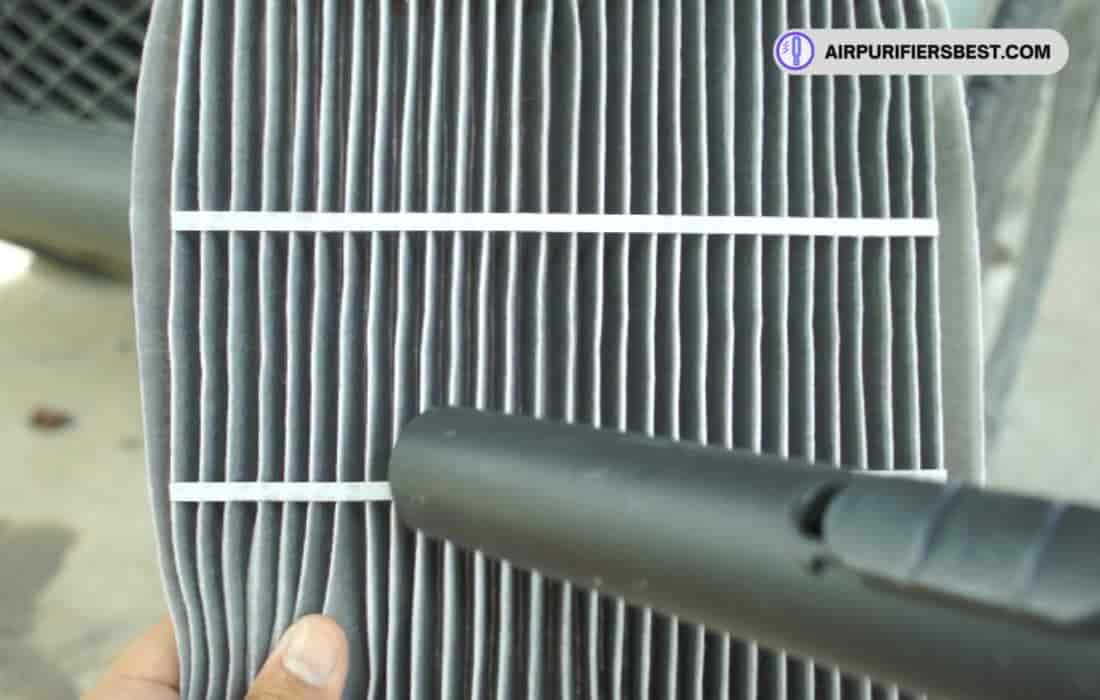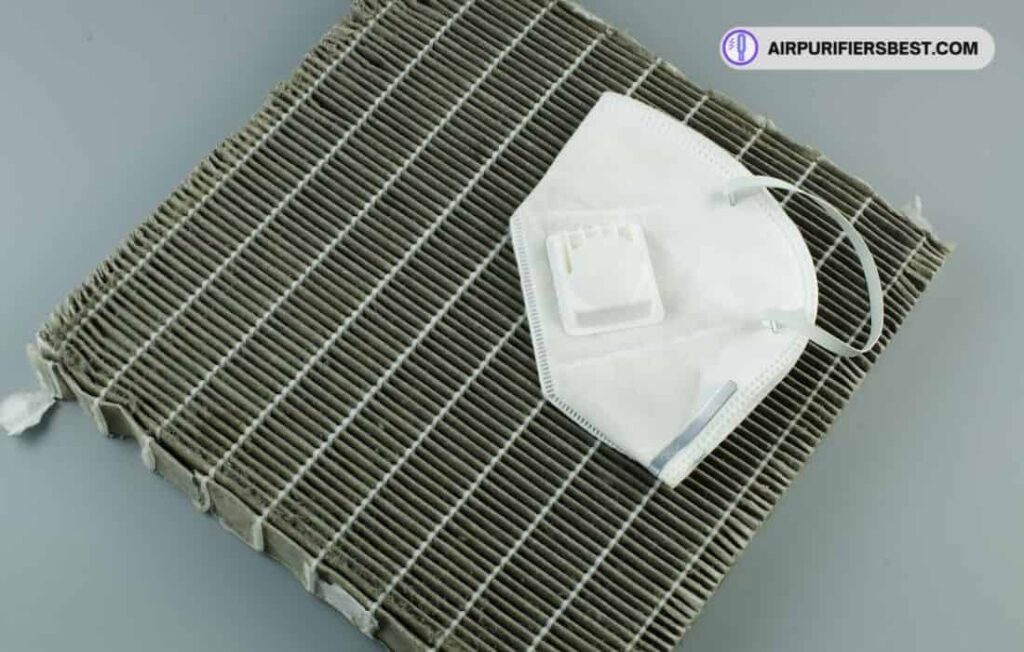HEPA filters are not reusable, implying they cannot be washed and used again. Therefore, they need to be replaced after a certain period. This frequency may be once in six months or one year, depending on usage. If the area where you are living is more polluted than usual, then you should change it every three months. For moderate use, it needs to be replaced once in six months.
You can also check the condition of the HEPA filter yourself every once in a while. If you find it to have discoloured to a black shade with a lot of trapped pollutants, it means it needs replacement. The black colour is usually due to the dirt and dust collected by the filter in the process of air purification. Never underestimate the importance of regularly replacing the HEPA filter, which helps your air purifier function more efficiently. With prolonged usage of the same filter, you may be compromising your health. A HEPA filter uses thin layers of porous material to capture small particles in the air. As it continues removing the material from the air, it becomes too full to capture more airborne particles. Ideally, you should change a HEPA air filter between 6 and 12 months. But that will also depend on indoor air quality, environmental factors, and usage.
Furthermore, those suffering from allergies or asthma should replace the HEPA filters in their air purifiers when their symptoms worsen or season allergies increase. Air purifiers can be beneficial for those who have asthma, allergies, and chemical sensitivities. They can improve air quality inside your home by trapping dirt, neutralizing foul odors, neutralizing smoke and chemical fumes, and eliminating germs.
However, to keep up such quality, air purifiers need regular maintenance and will periodically require filter replacements. Most air purifiers require filter changes to be made now and then, and the replacement schedule generally varies according to the type of filter. Knowing the degree of necessary upkeep by different air purifier types will help you make an informed purchase, as will this article, which highlights how the filters function in air purifiers to reinforce why replacement is so essential. It’s generally recommended to change them along these timelines: True HEPA: 8,760 usable hours or about every 12 months.


How to clean the Dyson air purifier filter?
- Switch off and detach your machine from the wall socket.
- Take off your Dysons filter, and select your specific machine from the selector below to find out how.
- Clean filters with cold water only.
- Usage of dry filters.
Replace the filters:
- It is a vacuum cleaner.
- A brush for dusting.
- Cloth with Soapy Water
The Dyson air purifier keeps the air in the home pure by eliminating dust mites. Purchasing a Dust Mite Air Purifier, on the other hand, is insufficient. You should clean the equipment regularly to maintain the air fresh. A filter is the most crucial component of a purifier machine, yet few people know how to clean a Dyson air purifier filter.
Here are the easy procedures for cleaning the filter:
- To begin cleaning, disconnect the electric socket from the outlet.
- Turn off the portable vacuum if you don’t want to part it.
- While the machine is turned on, you cannot begin cleaning.
- The essential components of an air purifier are filters.
- The majority of the filters are located near the cyclone.
- To clean, raise the hurricane, and remove the filter.
- They are usually purple in hue and easy to identify.
- Two filters are included in some Dyson upright vacuum tubes.
- Examine the rear of the machine or the ball.
- If there is another filter, remove that as well.
- When you open the filter, you’ll notice many clouds of dust and debris blocking it.
- Most of the holes are blocked by these dirt particles.
- When you open the filter, you’ll see many clouds of dust and debris clogging it.
- These dirt particles obstruct the majority of the filter’s pores.
- Clean the filth using the brush.
- Alternatively, you may use a vacuum cleaner to clean the filthy filter, which is both more accessible and more effective than using a brush.
- One of them can be used as a cleaning solution.
- Keep in mind that Dyson offers two types of filters.
- Check the user handbook with the product to see if your filter is waterproof.
- If the filter is waterproof, rinse it under the tap but do not immerse it in detergent or soapy water.
- If the filter is not watertight, soak it in
- soapy water with a towel.
- Squeeze the damp cloth and clean the filter with it.
How to dispose of an air purifier filter?
Here are a few disposal tips you can follow below:
1: Instantly put your used filter into a plastic bag.
The first and most important thing you need to do with your old air filter contains it to trap all of the dust and debris. A plastic trash bag is a great way to do this. Have a plastic bag ready when you change out your air filter, and immediately put your old filter into this bag when you remove it from your furnace or intake vent. Once the filter is inside, tie up the bag to trap as much dust and debris inside as possible. Do your best not to shake or bump the filter in the bag too much.
2: Don’t tremble(shake) the dirty air filter.
Air filters can appear dirty, but what you see may only be a portion of the dirt and debris one of these filters can contain. This dirt and rubbish can be relatively quickly unsettled, mainly if you shake a filter or bang it against something. Do your best to avoid doing this. In addition to visible dirt and debris, you may also be releasing several microscopic particles into the air, including mold spores, bacteria, viruses, and other things that could have been trapped in the filter up until that point. Do yourself a favour: quickly put your old filter into a plastic bag and avoid sudden movements with the old filter until the bag has been properly and completely sealed shut. Check out our next point to learn how to do that properly.
3: Tape the plastic bag shut.
Tying the drawstrings on a trash bag shut is one way to close off the majority of the opening to your bag, but it still isn’t going to completely seal the bag up and lock all the debris inside. Go the extra mile and use tape to seal your old air filter in the plastic bag. Video not only sticks to the plastic your bag is made from but also grabs hold of a lot of the dust or debris that may be trying to escape and holds it in place. Use an extra-sticky and robust form of tape, such as duct tape, to ensure a quality seal that won’t reopen quickly. Don’t be afraid to use a few extra strips of tape to close the bag fully—the better the seal, the cleaner your air will remain.
4: Dispose of Old Air Filters in an Outside Trash Can.
Don’t dispose of your old air filter indoors—take it to your outside trash can and toss it there. While you may be using the plastic bag to seal the dust and debris from your filter, bags can puncture or accidentally have holes poked in them. Even a tiny hole can allow some dust and debris into your air. Once you have the new air filter in place, immediately bring the old filter out to your trash can and throw it away there.
5: Never Leave Your HVAC System Without a Filter.
We feel this should go without saying, but permanently shut off your air conditioner or heater when replacing your air filter to ensure no un-filtered air is forced through the system. Dust and debris entering your HVAC system while your air filter is removed can cause havoc on your most vital equipment.
FAQs:
What if I Use My Purifier in a Dirty Place, or For Longer Each Day?
How frequently you need to change your HEPA filter depends on your exact usage and air pollution Situation. As such, we supply this handy tool to work out how often you should return to its place
Your air purifier HEPA filter.
How to Know When to Replace Your HEPA Filter?
Many factors regulate the continuance of your HEPA filter (location, speed used, time used, etc.). Air purifier corporations also often have little clarification for where they came up with their numbers.
Will an Air Purifier Protect My Entire House?
Sometimes. The packaging will tell you the maximum area (per square foot) that the air purifier can protect. Comparing this square footage to that of your home should help you better understand what’s needed.
Are There Side Effects to an Air Purifier?
Generally speaking, there are no side effects. However, there are a few purifiers on the market that use electrostatic precipitators and ionizers; these *may* emit small levels of ozone. Before buying an air purifier, make sure to check the product specifications.
Do Air Purifiers Make Noise?
For any air purifier to be effective, it has to move the air. There is no way to do this silently (despite what’s been advertised). However, with most air purifiers, there’s a noise level setting that can be adjusted based on preference.
Conclusion:
The HEPA filters are the latest technology air filters that last longer. It means valuing your loved ones and those who will spend time in the space. Everyone will benefit, especially those with sensitive immune systems. An air purifier dramatically reduces pollutants and allergens in the air, helping people to breathe easier and live healthier lives.




